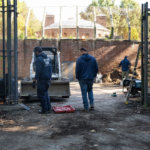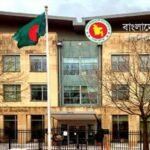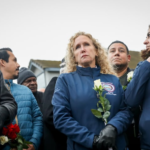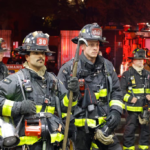Tuesday, May 14, 2024
Year : 2, Issue : 20
The hours after 300 protestors were arrested by New York City police at Columbia University New York. After days of rising tensions on certain American college campuses, pro-Israel activists today stormed a pro-Palestinian demonstration camp at the University of California, Los Angeles.
Before police arrived on campus, people were seen using sticks or poles to pound on wooden planks that were being used as temporary barricades to defend the pro-Palestinian protestors in eyewitness footage from UCLA that were confirmed by Reuters. The pro-Palestinian camp was then attempted to be destroyed by the assailants, who were holding Israeli flags. They attacked the students with metal fencing, sticks, stones, and pepper spray. Investigative journalist Joey Scott told Al Jazeera that students redirected the metal fencing hurled at them to protect themselves while police stood by and did nothing. A group allegedly swarmed on top of one person who was lying on the ground and kicked and battered them until others got them out of the scrum before the cops arrived. Witnesses claimed that after almost four hours of the attacks, which began overnight into Wednesday, the Los Angeles Police Department (LAPD) finally stepped in. The attacks had begun when hundreds of masked pro-Israel counterdemonstrators appeared outside the university campus and threw fireworks into the encampment.
According to Rob Reynolds of Al Jazeera, who is reporting from Los Angeles, the student protestors have maintained their position. He stated that while the exact number of casualties was unknown, postings on social media suggested that some victims had been taken away from the area hurt. He called the sight a “really shocking and ugly scene of violence.” For over seven hours, the attack persisted, and the only defense we had was one another. It continued in a statement published on X, saying, “The university would rather see us dead than divest.”
As the US student protests approach November’s presidential election, Republicans are accusing university administrators of ignoring antisemitic remarks and harassment. This has given the protests a political bent. During the peak of the turmoil on American campuses this week, where Republicans were eager to use student unhappiness as a political football to help Donald Trump win the presidency again, Joe Biden attempted to find a middle ground.
After balancing the political need to quell disturbances with the democratic right to peaceful protest, Biden stated that “order must prevail.” “This is not a peaceful protest—this is about intimidating people, frightening people, and instilling fear in people,” Biden declared in a statement on Thursday. “Democratic systems require dissent… The right to protest is there. But not the authority to unleash mayhem. Is it really mayhem or trying to suppress voices of the right. Regarding the demonstrations on campuses against Israel’s attack in Gaza, his remarks were his most noteworthy yet. Biden may find the protests to be a minefield.
Young people everywhere are furious over the Israeli-Palestinian issue, including college students. In addition, concerns about the cost of living, job stability, mental health, and the consequences of the 2024 presidential election are plaguing millennials and Generation. The accumulation of these problems causes us to feel cut off from the political system and challenges us to develop new avenues for civic engagement. It emphasizes how crucial it is to use the First Amendment’s protections wisely and give young adults a seat at the decision-making table.
Since the middle of the 20th century, college-aged students have been the vanguard of large-scale protests. Furthermore, the Black Lives Matter movement’s unity—especially in the wake of Breonna Taylor and George Floyd’s deaths—and the young voter turnout in the 2022 presidential midterm election serve as noteworthy illustrations of how closely young people are watching our political and economic environment and how eager they are to participate in politics.
In the end, the question for our elected and institutional leaders is still the same: How do we maintain a culture of civility where all constituents affected by overwhelming and traumatic challenges feel like they belong to find practical solutions in the face of war, national scrutiny, and social justice concerns?
The task of coming up with substantive answers to complex political issues is real, but successful outcomes can only be achieved when First Amendment rights are respected and polite channels of communication are established between young people engaged in protest and American institutions.







